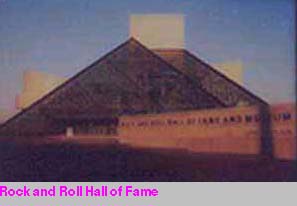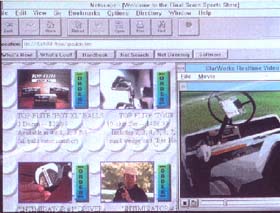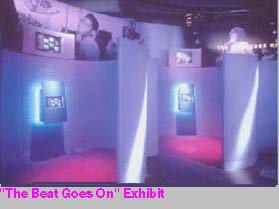The Rock and Roll Hall of Fame and Museum
Sun servers prove best at handling demanding multimedia networking
needs of Cleveland's dazzling museum
By Erica Liederman
Special to Sun Catalyst
The Rock and Roll Hall of Fame and Museum, located on the shores of
Lake
Erie in Cleveland, Ohio, debuted its collection of rock and roll music and
memorabilia
in September, 1995. The museum is the world's largest and most inclusive
collection of
recordings and exhibits relating to the history and genealogy of rock and
roll. Its
mission is to preserve, celebrate, and assist in the interpretation of the
music that has
been the backbone of American popular culture for over four decades.
 Designing the environment, interior space, and delivery system for a
set of
exhibits meant to capture the ever-evolving spirit of rock and roll (with
the emphasis
on 'ever-evolving') was no mean feat, involving a marriage of the talents
of architects,
exhibit designers, museum curators, engineers, construction companies and
civic
authorities. Moreover, it required the implementation of entirely new
computer
networking techniques to deliver multimedia applications to the kiosks and
interactive video displays that are the centerpiece of the museum's dynamic and
innovative exhibits.
Designing the environment, interior space, and delivery system for a
set of
exhibits meant to capture the ever-evolving spirit of rock and roll (with
the emphasis
on 'ever-evolving') was no mean feat, involving a marriage of the talents
of architects,
exhibit designers, museum curators, engineers, construction companies and
civic
authorities. Moreover, it required the implementation of entirely new
computer
networking techniques to deliver multimedia applications to the kiosks and
interactive video displays that are the centerpiece of the museum's dynamic and
innovative exhibits.
The Mothers of Invention
The Rock and Roll Hall of Fame and Museum was the brainchild of several
members of the music industry who, in 1983, created the Rock and Roll Hall
of Fame
Foundation to honor the men and women who have made major and abiding
contributions to the art of rock and roll. Through the foundations
efforts, $92 million
was raised, and on June 7, 1993, ground was broken for the museum's
construction.

The building itself was designed by the architect I.M. Pei, who is
noted for his
signature geometric glass-and-steel forms and cantilevered spaces. The
museum
consists of a 162-foot tower supporting a triangular glass tent that
extends (at its base)
onto a 65,000 square-foot plaza. The building's six floors house more
than 50,000
square feet of exhibition areas, administrative offices, libraries,
archives, and public
amenities.
The Burdick Group of San Francisco designed the building's interior,
the
exhibits, and the interactive audio and video kiosks. All of the video
and audio at the
museum's 25 interactive kiosks is stored on a Sun Microsystem's
SPARCserver 20 that
also houses StarWorks, Starlight Network's multimedia networking
application
software. The network system was designed and installed by CIBER Network
Services
of San Francisco.
Rocking Around the Clock
Creative and technical design of museum's interior began back in
October of
1994. Steve Kinstler, Account Manager of CIBER Network Services became
involved in
the project as a result of CIBER's relationship with the Burdick Group.
In 1991, CIBER
upgraded Burdick's computer network from Local Talk to Ethernet, and was
hired to
maintain their Macintosh network. Bruce Burdick, one of the principals of
The Burdick
Group, whose expertise had been focused primarily on interior design, had
begun
negotiating the design of the Rock and Roll Hall of Fame and Museum with
the
Museum's Board of Directors. "One day," said Kinstler "he called me and
said 'Let's do
The Rock and Roll Hall of Fame....'"
Kinstler and Burdick visited the Holocaust Museum in Washington D.C. to
get some ideas about how an interactive, kiosk-based museum might work.
The
networked computer system that delivers the multimedia displays at the
Holocaust
museum is PC based. Using a NetFrame server with PCs as clients, visitors
select an
item from kiosk screen, and wait for several minutes while the data is
loaded. Said
Kinstler: "It took too long." And for rock and rollers, whose attention
span is "very
brief" according to Kinstler - who spent considerable time monitoring
kiosk use during
the first few days the Rock and Roll Hall of Fame and Museum was open -
'too long'
would just not do. Kinstler decided to try a Macintosh solution. CIBER set
up a system
to display video across an Ethernet network with Macintosh clients. They
tested their
design in October, 1994.
"It worked partially," recalled Kinstler. "Files got to clients in two
seconds.
The quality wasn't bad. We strung twenty-five kiosks together and ran it
as an
interactive system. The problem was, the Ethernet network made the images
jerky.
Novell [Netware] doesn't have the redundancy and fault tolerance." In
April of 1995,
they came up with another prototype. This time they used a Token Ring
network with
a Netware SFT3 redundant server. But performance still fell short of the
mark. The
problem this time wasn't the server or the network software. It was the
Macintosh.
Kinstler recalls, "The server did fine, the wire [network] did fine. But
the Mac just
couldn't reassemble the packets on that end. It kept dropping packets and
losing
packets..." resulting in very poor image and audio quality.
Kinstler found the solution to the problem in StarWorks video networking
software from Starlight Networks.
 "One of the advantages of StarWorks was that the software doesn't care
what
client it has. The server can be an Intel or RISC system, and clients can
be any
combination of Mac, PC or Unix."
"One of the advantages of StarWorks was that the software doesn't care
what
client it has. The server can be an Intel or RISC system, and clients can
be any
combination of Mac, PC or Unix."
For the Rock and Roll Hall of Fame and Museum, CIBER initially decided
on
HP netservers with ten 100BaseT switches and Macintosh clients. Then Sun
Microsystems heard about the project from Starlight Networks, who is one
of their
vendor partners, and donated two SPARCserver 20 workstations to the
project. With
the addition of two hubs and ten high-performance switches, CIBER now had
a system
with sufficient redundancy: if a server went down, or a hub went down the
show still
went on. The configuration that was finally put in place consisted of
Macintosh
Quadra 840AV clients networked in a star topology using 10BaseT through a
Lannet
hub to 100BaseT on the Sun server. The server currently stores 20
gigabytes of data,
which will grow as new songs and video footage are added to the exhibits.
Said Kinstler: "Bandwidth is a major issue for network delivery of
multimedia.... StarWorks software provided the high degree of reliability
we needed to
deliver high-quality full-frame video from the Sun server to all of the
kiosks
immediately upon request."
The crucial test of the system came last September, on Labor Day
weekend
when the Museum opened its doors to the public.
The crowds were huge: between 9,000 and 10,000 people per day came to
Museum during that first weekend. Kinstler was on site, monitoring
workstation and
network use and de-bugging on the fly.
"During the first two days," recalls Kinstler, "the hardware was great
and the
software was buggy. Initially we had between twelve and fifteen incidents
an hour -
audio dropping, network spikes, a workstation down." But by the time
Labor Day
Monday rolled around, there were no incidents at all.
Of the Museum's system, Jim Long, President of Starlight Networks
said:
"The Sun/Starlight server and multimedia network allow the museum to
provide a
degree of interactivity and flexibility in its exhibits that it wouldn't
otherwise have.
The museum's kiosk system is a highly visible example of how multimedia is
being
shared over networks for a wide variety of applications."
Hail, Hail, Rock and Roll
There are many reasons that the Rock and Roll Hall of Fame and Museum
is
unique among museums. For one thing, it is the only museum in the world
where
most of the visitors already own the art. Moreover, most visitors are -
or consider
themselves - experts on the subjects of the exhibits. For this reason,
when the Burdick
Group designed the installation, they very deliberately made the exhibits
accessible on
many levels which allowed visitors to decide for themselves how much depth
they
wanted.
Content was divided into four areas: the historical perspective, which
includes influences of performers on one another; the social perspective,
which
includes the music's effect on fashion, politics and daily life; the
performers'
perspective; and the fans' perspective. But the divisions are
deliberately soft edged so
that rather than having a hall devoted to one theme, and an enclosed room
devoted to
another, a total environment is created.
"It's a different experience from your usual museum," said Bruce
Lightbody
who managed the Rock and Roll project for the Burdick Group. "For one
thing, it's
noisy. People stand there at the kiosks with the earphones on rocking and
singing
away. People are laughing and running between exhibits..." Except inside
the Hall of
Fame itself, which occupies the sixth floor of the building, there is no
one walking
around speaking in a reverential whisper. There are four main interactive
exhibits
located on the ground and second floors of the Museum.
The "Rock and Roll Music" exhibit contains a database of 500 songs that
shaped rock and roll.
 "The Beat Goes On" demonstrates how various groups were influenced by
other artists. In this exhibit, the visitor selects a music style from a
list of nine styles -
such as Folk Rock, Rockabilly or British Invasion - by touching the
selection on the
screen. If he or she chooses British Invasion, the second screen offers a
choice of
performers, among them groups such as The Rolling Stones, The Animals and
The Beatles. If The Beatles is selected, a third screen appears showing the
members of the
band, and two of the band's major influences, in this case Little Richard
and Carl
Perkins. Touching the monitor on the image of the artist causes a song
composed by
that artist to be played.
"Come See About Me" is a database of performers, and contains interviews,
information and history of each of the performers. The visitor chooses an
era, from the
1930s to the 1990s and touches the screen to view a list of performers
active during that
era. Successive screens allow him or her to listen to songs and watch
video clips of
interviews with the artists.
"The Beat Goes On" demonstrates how various groups were influenced by
other artists. In this exhibit, the visitor selects a music style from a
list of nine styles -
such as Folk Rock, Rockabilly or British Invasion - by touching the
selection on the
screen. If he or she chooses British Invasion, the second screen offers a
choice of
performers, among them groups such as The Rolling Stones, The Animals and
The Beatles. If The Beatles is selected, a third screen appears showing the
members of the
band, and two of the band's major influences, in this case Little Richard
and Carl
Perkins. Touching the monitor on the image of the artist causes a song
composed by
that artist to be played.
"Come See About Me" is a database of performers, and contains interviews,
information and history of each of the performers. The visitor chooses an
era, from the
1930s to the 1990s and touches the screen to view a list of performers
active during that
era. Successive screens allow him or her to listen to songs and watch
video clips of
interviews with the artists.
"Dedicated to the One that I Love" offers audio air checks of disk
jockeys of
the past in every major American city.
The Hall of Fame itself, located on the sixth floor of the building is
reached by
climbing a spiral staircase from the fifth floor. The room is smaller
(40'x40') than the
other exhibit areas, and contains no interactive kiosks. Instead, sixty
LCD screens
display images and concert film footage of the Hall of Fame inductees.
These
continuously running displays are not interactive. Each is powered by a
dumb PC
playing a programmable disk. The Hall of Fame itself is the one section
of the Museum
that visitors experience as museum-like. It's quiet; the room is dark; the
displays are
behind glass walls.
Dancing in the Street
Interactive multimedia exhibits are redefining the concept of
'museum.'
Dennis Barrie, director of the Rock and Roll Hall of Fame and Museum said
"We want
to both entertain and educate our visitors through a participatory
multimedia
experience that captures rock's energy and excitement. We have an
opportunity to
invent a brand new kind of museum."
And what do the critics say? The Washington Post's Richard Harrington
wrote: "It's already a museum of substance, not just style, as well as a
fun tourist
attraction with a historic purpose." Los Angeles Times pop music critic
Robert Hilburn
wrote: "This is a world-class showcase, whose colorful exhibits combine a
lively
entertainment value with a faithful aura of scholarship."
And the artists themselves? In an interview on ABC TV's "Nightline,"
Aretha
Franklin commented: "When you get inside, you immediately feel a sense of
greatness
and warmth....
"Anyone that happens to be a music lover, this is a must...."
Back to Front Page
Erica Liederman (erica.liederman@sunworld.com) is a free-lance writer based in North Fork, CA.
 Designing the environment, interior space, and delivery system for a
set of
exhibits meant to capture the ever-evolving spirit of rock and roll (with
the emphasis
on 'ever-evolving') was no mean feat, involving a marriage of the talents
of architects,
exhibit designers, museum curators, engineers, construction companies and
civic
authorities. Moreover, it required the implementation of entirely new
computer
networking techniques to deliver multimedia applications to the kiosks and
interactive video displays that are the centerpiece of the museum's dynamic and
innovative exhibits.
Designing the environment, interior space, and delivery system for a
set of
exhibits meant to capture the ever-evolving spirit of rock and roll (with
the emphasis
on 'ever-evolving') was no mean feat, involving a marriage of the talents
of architects,
exhibit designers, museum curators, engineers, construction companies and
civic
authorities. Moreover, it required the implementation of entirely new
computer
networking techniques to deliver multimedia applications to the kiosks and
interactive video displays that are the centerpiece of the museum's dynamic and
innovative exhibits.

 "One of the advantages of StarWorks was that the software doesn't care
what
client it has. The server can be an Intel or RISC system, and clients can
be any
combination of Mac, PC or Unix."
"One of the advantages of StarWorks was that the software doesn't care
what
client it has. The server can be an Intel or RISC system, and clients can
be any
combination of Mac, PC or Unix."
 "The Beat Goes On" demonstrates how various groups were influenced by
other artists. In this exhibit, the visitor selects a music style from a
list of nine styles -
such as Folk Rock, Rockabilly or British Invasion - by touching the
selection on the
screen. If he or she chooses British Invasion, the second screen offers a
choice of
performers, among them groups such as
"The Beat Goes On" demonstrates how various groups were influenced by
other artists. In this exhibit, the visitor selects a music style from a
list of nine styles -
such as Folk Rock, Rockabilly or British Invasion - by touching the
selection on the
screen. If he or she chooses British Invasion, the second screen offers a
choice of
performers, among them groups such as